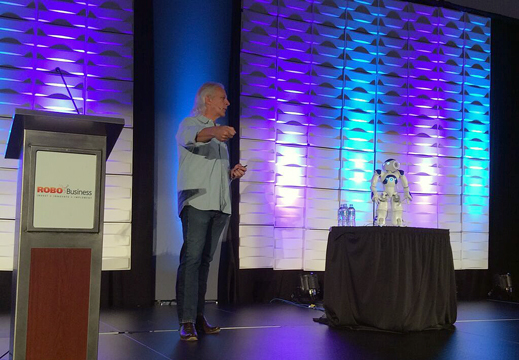IBM Wants Watson to Teach Robots Some Social Skills
IBM is using some of the artificial-intelligence techniques that emerged from its Watson project to teach robots to better understand and mimic human communication.

During a keynote speech at a conference called RoboBusiness held in San Jose, California, this week, Robert High, chief technology officer of Watson at IBM, demonstrated some of the techniques his team is working on using a small humanoid robot.
The robot, a Nao model from the company Aldebaran, spoke with realistic intonation and made appropriate hand gestures during a conversation with High. It even exhibited a little impatience and sarcasm, miming looking at its watch, for example, when asking High to hurry up with his talk.
Speaking with MIT Technology Review after the demo, High admitted that this interaction was prerecorded, because the system doesn’t always work well in noisy environments. But he said the capabilities demonstrated reflected real research. His team is using machine-learning algorithms to learn from video footage to associate appropriate gestures and intonations with different phrases. High says it is important to do this because language alone is only part of human communications.
“We augment the words with physical gestures to clarify this and that,” High said. “You can bring into the [robot] interface this gesturing, this body language, the eye movement, the subtle cues that we as humans use when we communicate with one another to reinforce our understand of what we’re expressing.”
Robot interaction is becoming an important issue as industrial robots start moving into new settings, requiring them to work alongside people, and as companies try to develop robots for use in stores, offices, and even the home.
High added that the project was still at an early stage. “We’re still experimenting, seeing what’s doable and what’s useful, and what will have economic interest,” he said.
IBM used a range of artificial-intelligence techniques to develop Watson, which proved capable of winning the game show Jeopardy! after mining vast quantities of information and extracting meaning from the text (see “A Worthwhile Contest for Artificial Intelligence”).
That effort has evolved into a much broader project involving many more AI approaches under the umbrella term “cognitive computing” (see “Watson Adds Deep Learning to Its Repertoire”). IBM has made many of the machine-learning capabilities developed through this program available to developers through an online application-programming interface.
Some robot makers are already testing these APIs as a way give their products the ability to answer queries spoken in different ways, and to look up useful information (see “A Japanese Robot Is Learning the American Way”).
Keep Reading
Most Popular
Large language models can do jaw-dropping things. But nobody knows exactly why.
And that's a problem. Figuring it out is one of the biggest scientific puzzles of our time and a crucial step towards controlling more powerful future models.
The problem with plug-in hybrids? Their drivers.
Plug-in hybrids are often sold as a transition to EVs, but new data from Europe shows we’re still underestimating the emissions they produce.
How scientists traced a mysterious covid case back to six toilets
When wastewater surveillance turns into a hunt for a single infected individual, the ethics get tricky.
Google DeepMind’s new generative model makes Super Mario–like games from scratch
Genie learns how to control games by watching hours and hours of video. It could help train next-gen robots too.
Stay connected
Get the latest updates from
MIT Technology Review
Discover special offers, top stories, upcoming events, and more.